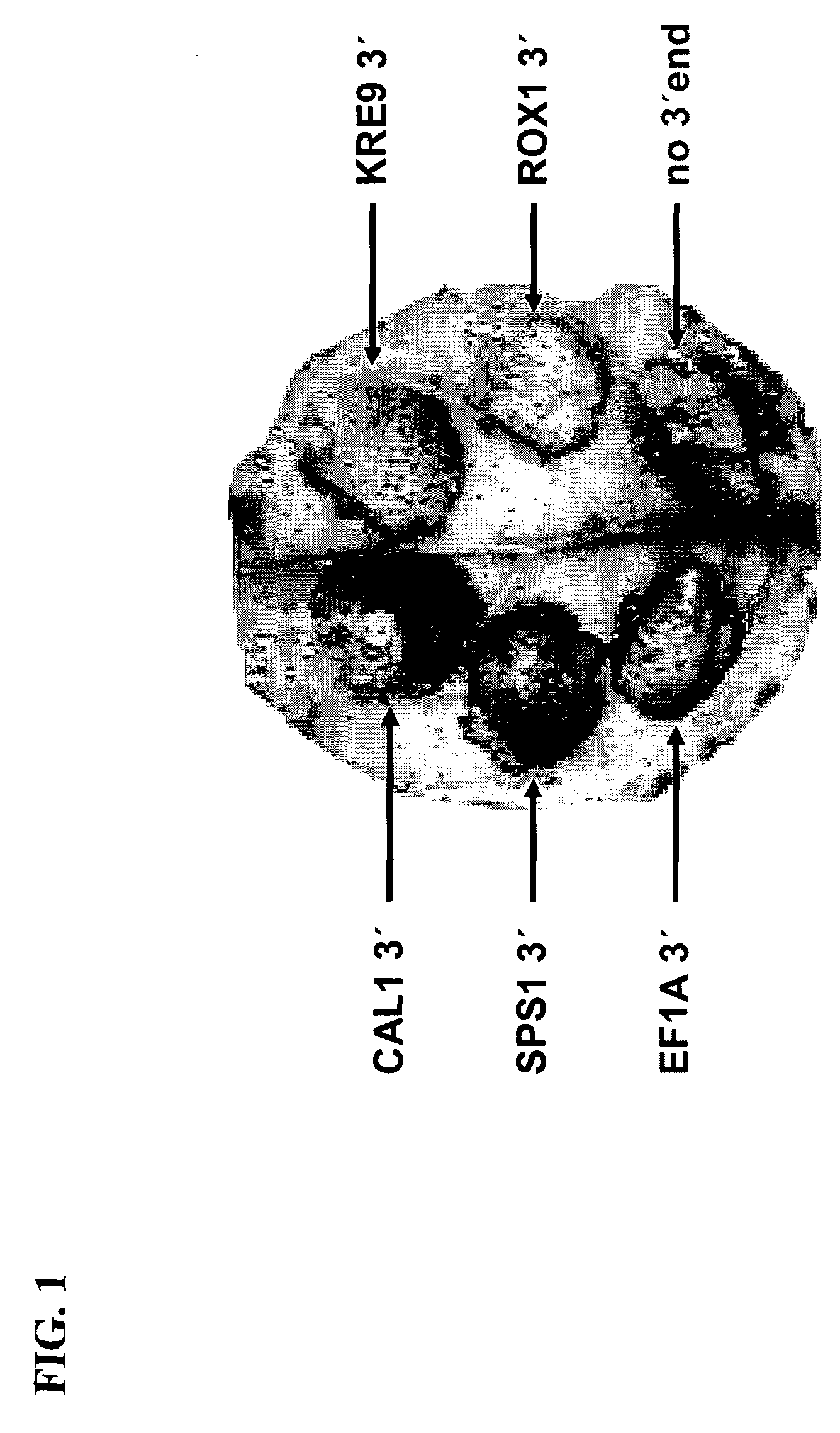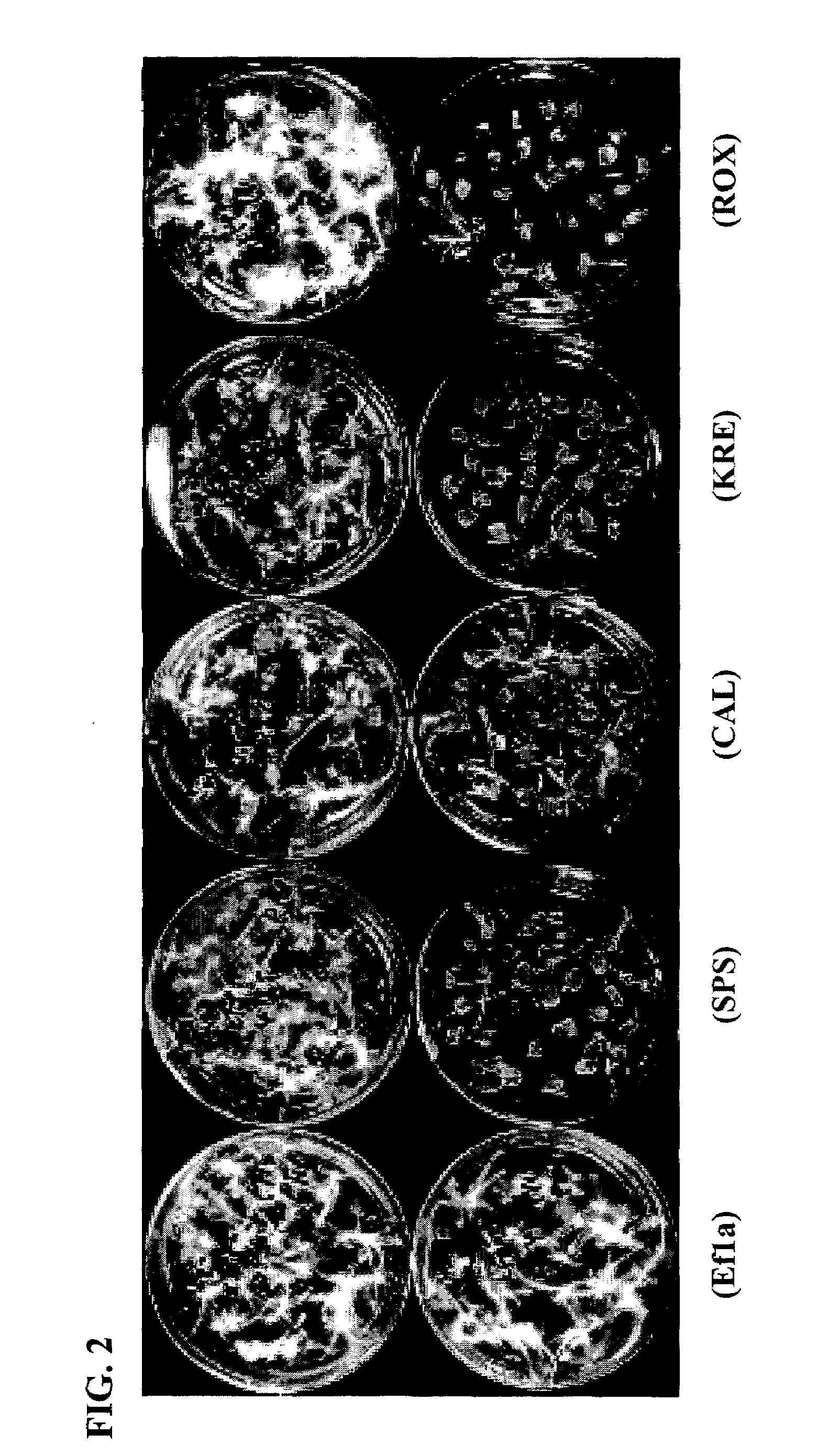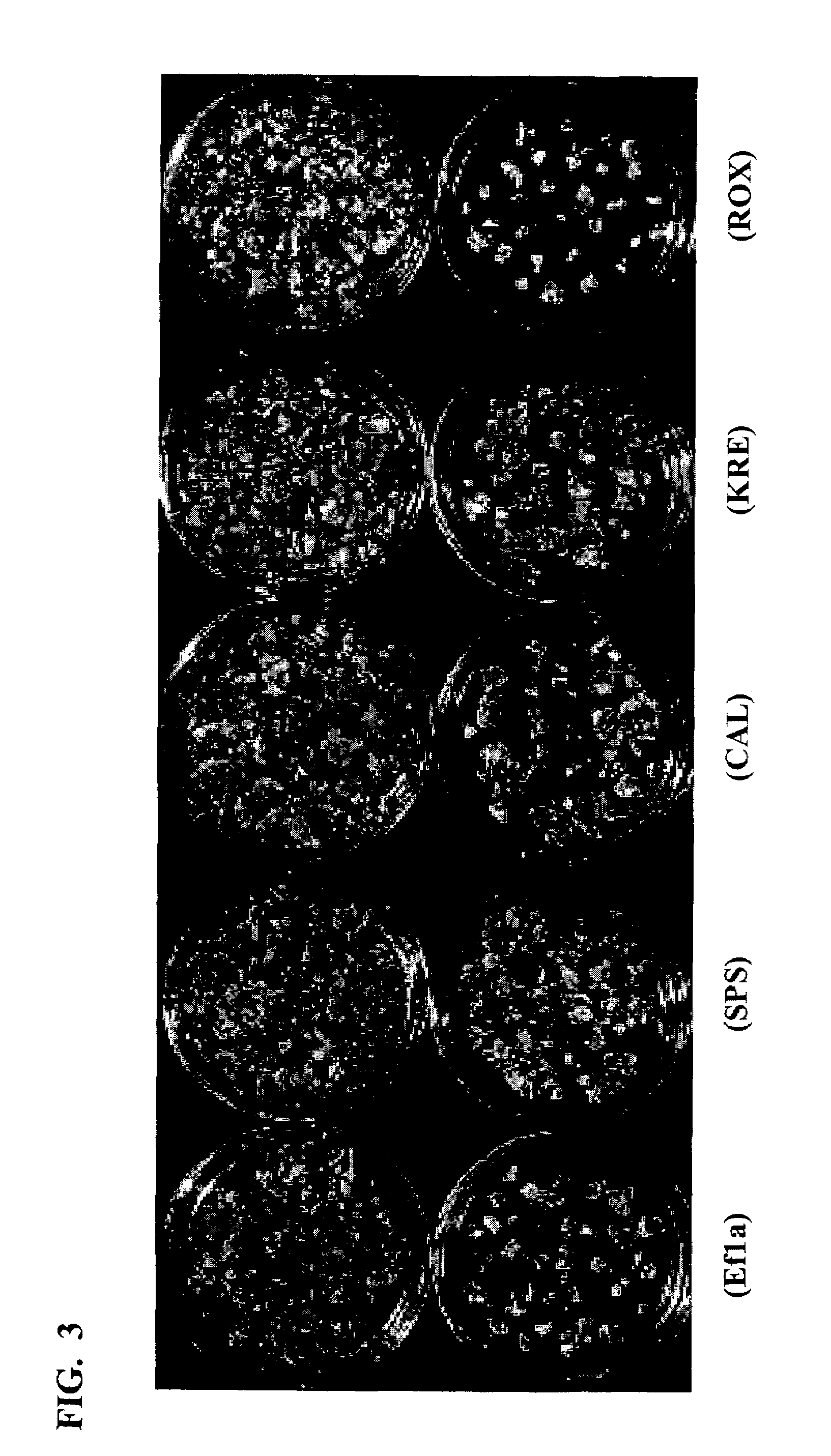Recombinant expression cassettes with a fungal 3′ termination sequence that function in plants
a technology of recombinant expression cassettes and plants, which is applied in the field of heterologous genetic constructs comprising plant expression cassettes, can solve the problems of increasing the complexity of expressing foreign genes in plant cells, failure to achieve the effect of expressing foreign genes with non-plant 3′ termination sequences, and scarcity of 3′ termination sequences suitable for use in plant expression vectors for heterologous genes
- Summary
- Abstract
- Description
- Claims
- Application Information
AI Technical Summary
Benefits of technology
Problems solved by technology
Method used
Image
Examples
example 1
Isolation and Amplification of Saccharomyces cerevisiae CAL1 3′ Termination Sequence
[0217]Studies by the applicants have shown that at least three 3′ termination sequences isolated from the yeast Saccharomyces cerevisiae function in plants as part of a heterologous expression cassette. The present example describes the isolation of one of these sequences by PCR amplification.
[0218]Oligonucleotide primers for PCR amplification were synthesized on an Applied Biosystems 394 DNA synthesizer using established phosphoramidite chemistry, precipitated with ethanol according to standard protocols, and used in the amplification reaction without further purification. The sequences of the synthetic primers were:
[0219]
SEQ ID. NO:45′-GCGCGCGGAAGGAGGAAAGTGACTCCTTCGTTGC-3′SEQ ID. NO:55′-GGTACCTCATCATTTGGAGGTTCAAGTCATGGAG-3′
A BssH II restriction site (5′-GCGCGC-3′) and an Asp718 I restriction site (5′-GGTACC-3′) were incorporated at the ends of the SEQ ID. NO:4 and SEQ ID. NO:5 primers, respectively...
example 2
Construction of a Recombinant Expression Cassette Using the CAL1 3′ Termination Sequence and Testing Non-Plant 3′ Termination Sequence Function in Plants
[0221]This example describes the construction of a reporter expression cassette for testing 3′ termination sequence functionality in plants. The reporter expression cassette comprises a dMMV promoter (Dey and Maita, Plant Mol Biol 40: 771-782 1999) operably linked to a β-glucuronidase (GUS) reporter gene containing a plant intron and a glycine-rich protein signal peptide secretion signal (Jefferson et al., PCT WO99 / 13085). The Call 3′ end was sub-cloned from the pCR2.1-Topo vector as a BssH II-Asp718 I fragment into the BssH II-Asp 718 I sites of the plant binary vector pMAXY-3768 (Right border-dMMV promoter-GFP-[BssH II]Arabidopsis EF1a 3′ end[Asp718 I]-Left border). The “GUSplus+intron+SP” sequences derived from pCAMBIA1305.2 were subcloned from pMAXY-3568 as an Nco I-Asc I fragment into the Nco I-BssH II sites of the above vector...
example 3
Constructing a Heterologous 3′ Termination Sequence that is Functional in Plants from the 3′ Termination Sequence from Human Genes
[0228]The following primer sets were used to PCR amplify 3′ termination sequences from the genomic sequences corresponding to the indicated GENBANK accession numbers by using the PCR amplification method described in example 1 above.
[0229]
PRIMER NAMEPRIMER SEQUENCEGENBANK REFERENCEhLaminLF5′- GGCGCGCCTAGGCCAAGCCCTGCGTCCAGCGAGC -3′GENBANK AC#: M94363(SEQ ID NO:10)(SEQ ID NO:66)hLaminLR5′- CGGGGTACCCCGAGTCAGCTTGTGCAACAGCGTCG -3′(SEQ ID NO:11)hLaminSF5′- GGCGCGCCTAGGGAAGCCTGCACGCGGCAGTTC -3′GENBANK AC#: M94363(SEQ ID NO:56)(SEQ ID NO:66)hLaminSR5′- CGGGGTACCCCGGAATAAACTCAGAGGCAGAAC -3′(SEQ ID NO:57)hC2F5′- GGCGCGCCTAGGCTAGCCATGGCCACTGAGCCCT -3′GENBANK AC#: L09708(SEQ ID NO:58)(SEQ ID NO:67)hC2R5′- CGGGGTACCCCGCCAAGGCCAGCCCTACCTGGC -3′(SEQ ID NO:59)UBQF5′- GGCGCGCCTAGGTGGCTGTTAATTCTTCAGTCATGGC -3′GENBANK AC#: X04803(SEQ ID NO:60)(SEQ ID NO:68)UBQR5′- CGGGGTAC...
PUM
| Property | Measurement | Unit |
|---|---|---|
| temperatures | aaaaa | aaaaa |
| temperatures | aaaaa | aaaaa |
| temperatures | aaaaa | aaaaa |
Abstract
Description
Claims
Application Information
 Login to View More
Login to View More - R&D
- Intellectual Property
- Life Sciences
- Materials
- Tech Scout
- Unparalleled Data Quality
- Higher Quality Content
- 60% Fewer Hallucinations
Browse by: Latest US Patents, China's latest patents, Technical Efficacy Thesaurus, Application Domain, Technology Topic, Popular Technical Reports.
© 2025 PatSnap. All rights reserved.Legal|Privacy policy|Modern Slavery Act Transparency Statement|Sitemap|About US| Contact US: help@patsnap.com



